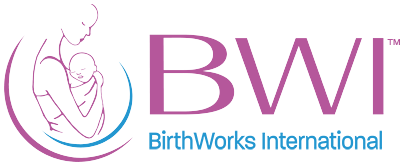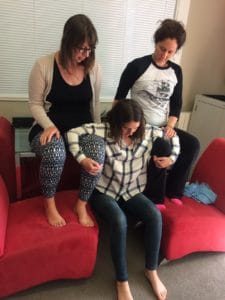Table of Contents:
A quick reminder about the amazing pelvis!
Two important pelvic exercises to prepare for birth
Optimal Pelvic Positioning for pregnancy, labor & birth
Positioning during labor should feel good
What should I do right now to prepare for my birth?
As you prepare for your upcoming birth, you may be starting to think about labor positions. In fact, there is a lot to be said for the physical preparation leading up to labor. And it doesn’t stop once your body goes into labor. Movement becomes even more important when you’re having contractions.
Yes, you read that right. Moving during contractions is so important! More on that later.
But what’s all the fuss? Is it really THAT important to know different labor positions? Should you spend time learning and even possibly trying them out BEFORE you start labor?
The short answer is yes – learning and trying different labor positions will help! Your body will also intuitively move into great positions. So, by both using your intuition and knowing some basics about posture and pelvic positioning, you’ll give your baby space to move through the birth canal.
A quick reminder about the amazing pelvis
The bones within the pelvis were designed to move during birth. The movement is subtle and functional! The goal of prenatal movement preparation is to realize that the pelvis has mobility and for you to understand the roles that gravity and position play in how the pelvis accommodates for the baby.
A basic understanding of your pelvis will help you get into the most beneficial positions during your labor. You may also be able to alleviate pressure and tightness as your pregnancy progresses by learning how to move more functionally. Seeking outside resources is a great idea during pregnancy. Birth doulas, physical therapists, chiropractors, prenatal fitness experts may be best consulted with during your pregnancy as they can provide ideas for minimizing pelvic pain and tightness AND teaching you how the pelvis functions during birth.
Use these next two exercises to bring awareness about how the bones in the pelvis move and how important posture is during pregnancy.
Two important pelvic exercises to prepare for birth
1. Mobilizing your sacrum and tailbone
Here is a video tutorial and step by step directions below.
- Place your hand firmly over your sacrum and tailbone. Now manually move your sacrum and tailbone into a tuck – your fingers will guide your tailbone down and forward. Now manually move your pelvis into a tilt – your palm will guide your tailbone up and backward.
- Try the same experiment standing against a wall which may provide you with more kinesthetic feedback.
In pregnancy, especially the third trimester and then in labor the rule of thumb is to keep mobilizing your sacrum and tailbone and choose labor positions that allow this area to move freely, without being compressed (for example: lying on your back during labor often immobilizes this area).
2. Find your sit bones
Here is a video tutorial and step by step directions below.
- Sit in a chair that has a harder surface.
- Rock side to side to notice your sit bones – two bony landmarks on the bottom of your pelvis.
- Now slouch and notice how your tailbone tucks under and is compressed. Now lean forward and notice how you have shortened the muscles in your low back. Go back to neutral where you are sitting on your sit bones and notice how your posture is lengthened.
In pregnancy, sitting on your sit bones leads to better posture and keeps the muscles around the pelvis from shortening and becoming overtight. Avoiding slouched positions is also a key component of Optimal Pelvic Positioning.
Optimal Pelvic Positioning during pregnancy, labor & birth
Optimal Pelvic Positioning (OPP) is a way to keep your pelvis aligned well during pregnancy. OPP allows for an easier labor and birth due to intentional choices you make regarding how you sit, relax, and stand (Learn more about labor positions related to OPP and one very useful position). When we optimize our posture, we lessen the chance of tight muscle, ligaments and fascia and offer our growing baby more room in the uterus. The principles of OPP are especially important in the last six weeks of pregnancy.
During Pregnancy
- Feel your spine lengthening instead of slouching.
- When sitting, sit tall in your chair and on your sit bones. Being on your sit bones prevents the tailbone from tucking under as continually tucking under creates tightness in your pelvic floor muscles.
- Keep your knees below your waist. This doesn’t mean you can’t ever rest with your feet up on a couch but limit your time in this position as it tends to tuck your tailbone under.
- Avoid crossing your legs which can create tightness and imbalance in the pelvis.
- Spend time on your hands and knees. Cat/cow, crawling, or even scrubbing the floor all mobilize your spine and pelvis.
During Labor
- Keep moving. Moving during contractions will help you cope with the intensity and keep the pelvis mobile to offer room for baby to move through the birth canal.
- Standing positions offer the best use of gravity and movement in sacrum and tailbone. Some ideas are: swaying side to side, slow dancing with your partner or support person, standing with birth ball on the bed and you leaning over the ball, walking, standing in the shower and using hydrotherapy for relief.
- Sitting positions on a birth ball or chair that has been turned backwards, can give you support while keeping the sacrum and tailbone free. On a birth ball, sit leaning slightly forward, stabilizing yourself with hands on a bar, chair or bed. You can tuck and tilt your pelvis forward and backward, circle the hips, or take the hips to the right side and then the left side. Sitting with a chair that has been turned backwards gives you a place to drape your arms over the back of the chair. A partner or doula can offer massage as you take moments to rest.
- Kneeling positions keep the sacrum and tailbone free. Ideas: kneel with the birth ball in front of you and drape your torso over the ball, cat/cows, shifting torso and pelvis in directions that feel comfortable while on hands and knees.
- Side-Lying is a great way to rest. When you want to lie down, use side-lying with a peanut ball supporting your top leg. Ideally the knee of your top leg should be in line with your pelvis.
If you trust the process of birth, feel safe and can quiet your brain, your body will instinctively move through positions that help labor progress. Oftentimes the body will choose upright positions that allow gravity to help your baby move down.
Breathing your baby out
- Instead of thinking of the pushing phase being about force, allow your breath to bring your baby into the world. Holding your breath tightens your muscles instead of keeping them relaxed. Instead breathe and follow your body’s urge to open for birth.
- Stay off your back. Giving birth on your back compresses your sacrum and tailbone.
- Keep your knees in line with your toes instead of out to the sides (this can be applied in standing, kneeling or side lying positions when breathing your baby out).
- Keep your palms open and relaxed, which reduces tension in your entire body!
Your breath can be your reminder of positioning. If you’re pushing while lying on your back, it will often be hard to catch your breath or find deep inhales and exhales. Let your intuitive body move you to side-lying or up to hands and knees. Breathe your baby down and out.
Positioning during labor should feel good and help you cope with the waves of contractions!
Remember earlier when I told you we would come back to this idea of moving during contractions? Here it is…You know that feeling you get when you are on an airplane with little room to move and shift and your whole body feels tight when you get to your destination? Insufficient movement during labor can also cause this type of tightness in your body. Not changing positions frequently enough, or not listening to your body’s cues like “I’m uncomfortable,” “this doesn’t feel good,” can be a recipe for extra tension that we don’t need while giving birth. Instead, we want to manage the strength of contractions with gentle movement.
As a doula, I am constantly reminding my clients to move during contractions. When they move, they report feeling less pain/pressure. A mobile pelvis also helps the baby navigate the space in the birth canal. In an unmedicated birth, where you have full freedom of movement, your body will intuitively move into positions that “feel right.” These positions will often allow breath to flow freely through your body. This breath will help you stay calm.
When those big waves/contractions come, keep moving. Oftentimes when we feel pain, our body reacts by tensing up. A tense body creates more tension in the pelvic muscles which must open for birth. If you feel yourself starting to tense, start swaying and rocking side to side which can help you stay in the flow of movement. Swaying and rocking can also loosen up tense neck and face muscles, which will loosen up pelvic muscles.
You can rock and sway while standing up, kneeling, or sitting on the birth ball. If you’re in side-lying you can gently sway/rock your body a little bit forward and backwards. If side-lying with a peanut ball – a partner or doula can gently rock your legs forward and backward to create this relaxation/release of muscle tension. Slow dancing with your partner is also a great way to keep the pelvis moving and be in a position where gravity can bring your baby down.
What should I do right now to prepare for my birth?
Gentle exercise/movement! You’ve probably been told that movement and exercise during pregnancy serves many purposes. Less aches and pains, more mobility as your body changes and grows for baby, a more easeful pregnancy, etc. Movement during pregnancy also allows your body to get into great positions for labor.
This is because you have allowed your body to renegotiate space as your body literally grows and shifts to accommodate for your growing fetus. So don’t skimp on engaging in a movement practice that works for you. Gentle movement does wonders!
Jenny (Showalter) Miller is a mom of two, and a BirthWorks Birth Doula and Childbirth Educator. She loves supporting people as they transition to motherhood and believes that physical and mental preparation for labor go hand-in-hand. As a dance educator, somatic practitioner, and fitness professional, she has been educating about the body for 20 years. Her movement background helps clients develop a strong mind-body connection, learn more about their movement potential for a healthy pregnancy, labor and easeful postpartum recovery. Jenny is dual-certified with BirthWorks International and is currently serving on their Board of Directors. She also has a MFA in Dance, BS in Exercise Science, certification in Pilates and Yoga 200-hr, Personal Training, Registered Somatic Movement Therapist and a Certified Evans Technique Teacher (dance). She supports families in the western suburbs of Chicago: www.mamatomamabirth.com



